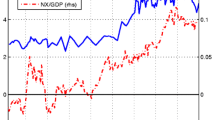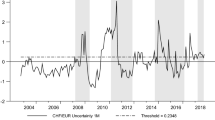Abstract
In this paper, it is shown that inflation differentials and trade deficits were significant determinants for exchange rate movements in the European monetary system. Since the target zone prevents EMS exchange rates from adjusting gradually to changing economic conditions, a standard regression model cannot detect this influence however. Therefore, a new econometric model is introduced, in which deteriorating competitiveness increases the probability of large depreciations and high volatility. These depreciations can be due to large devaluations or to panic reactions of the market due to expected devaluations. It is shown that the out-of-sample predictions of the model outperform the random walk, and that large arbitrage gains can be made in the foreign exchange market if our model predictions are used.
Similar content being viewed by others
REFERENCES
Bollerslev, T. (1986), ‘Generalized Autoregressive Conditional Heteroskedasticity,’ Journal of Econometrics, 31, pp. 307–327.
Diebold, F.X. (1987), ‘Testing for Serial Correlation in the Presence of ARCH,’ Proceedings from the American Statistical Association, Business and Economics Section, pp. 323–328.
Dominguez, K.M. and P.B. Keenen (1992), ‘Intramarginal Intervention in the EMS and the Target Zone model of Exchange Rate Behavior,’ European Economic Review, 36, pp. 1523–1532.
Dumas, B. and L.E.O. Svensson (1994), ‘How Long Do Unilateral Target Zones Last,’ Journal of International Economics, 36, pp. 467–481.
Frankel, J. and S. Phillips (1992), ‘The European Monetary System: Credible at Last?,’ Oxford Economic Papers, 44, pp. 791–816.
Giavazzi, F. and A. Giovannini (1989), Limited Exchange Rate Flexibility, Cambridge, MIT Press.
Kendall, M. and A. Stuart (1967), The Advanced Theory of Statistics, 2, Inference and Relationship, New York, Haffner.
Koedijk, K.G. and C.J.M. Kool (1993), ‘Betting on the EMS,’ Open Economics Review, 4, pp. 151–173.
Koedijk, K.G. and P. Schotman (1990), ‘How to Beat the Random Walk: An Empirical Model of Real Exchange Rates,’ Journal of International Economics, 29, pp. 311–332.
Koedijk, K.G., P.A. Stork, and C.G. de Vries (1992), Conditional Heteroskedasticity, Realignments and the European Monetary System, Working Paper, University of Limburg.
Krasker, W.S. (1980), ‘The “Peso Problem” in Testing Efficiency of Forward Exchange Rates,’ Journal of Monetary Economics, 6, pp. 269–276.
Krugman, P. (1991), ‘Target Zones and Exchange Rate Dynamics,’ Quarterly Journal of Economics, 56, pp. 669–682.
Krugman, P. and M.H. Miller (1993), ‘Why Have a Target Zone,’ Carnegie Rochester Series on Public Policy, 38, pp. 279–314.
Krugman, P. and J. Rotemberg (1990), Target Zones and Limited Reserves, NBER Working Paper 3418, Washington D.C.
Meese, A.K. and K.R. Rogoff (1983), ‘Empirical Exchange Rate Models of the Seventies: do they Fit out of Sample,’ Journal of International Economics, 14, pp. 3–24.
Nieuwland, F.G.M.C., W.F.C. Verschoor, and C.C.P. Wolff (1991), ‘EMS Exchange Rates,’ Journal of International Financial Markets, Institutions and Money, 2, pp. 21–42.
Palm, F.C. and P.J.G. Vlaar (1997), ‘Simple Diagnostic Procedures for Modeling Financial Time Series,’ Allgemeines Statistisches Archiv, 81, pp. 85–101.
Svensson, L.E.O. (1992), ‘An Interpretation of Recent Research on Exchange Rate Target Zones,’ Journal of Economic Perspectives, 6, pp. 119–144.
Ungerer, H., J.J. Hauvonen, A. Lopez-Claros, and T. Mayer (1990), ‘The European Monetary System: Developments and Perspectives,’ Occasional Paper, 73, IMF, Washington.
Vlaar, P.J.G. (1997), ‘German Interest Rates and the European Monetary System,’ in: P. Karadeloglou (ed.), Exchange Rate Policy in Europe, MacMillan Pub. Co.
Vlaar, P.J.G. and F.C. Palm (1993), ‘The Message in Weekly Exchange Rates in the European Monetary System: Mean Reversion, Conditional Heteroskedasticity and Jumps,’ Journal of Business and Economic Statistics, 11, pp. 351–360.
Vlaar, P.J.G. and F.C. Palm (1997), ‘Inflation Differentials and Excess Returns in the European Monetary System,’ Journal of International Financial Markets, Institutions and Money, 7, pp. 1–20.
Weber, A.A. (1991), ‘Reputation and Credibility in the European Monetary System,’ Economic Policy, 58–102.
Author information
Authors and Affiliations
Rights and permissions
About this article
Cite this article
Vlaar, P.J. Target Zones and Realignment Risk: An Integrated Approach. De Economist 146, 91–116 (1998). https://doi.org/10.1023/A:1003206009476
Issue Date:
DOI: https://doi.org/10.1023/A:1003206009476




